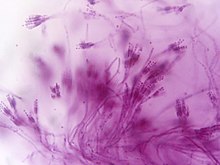This article may be too technical for most readers to understand. (August 2018) |
| Penicillium | |
|---|---|

| |
| Penicillium sp. | |
| Scientific classification | |
| Domain: | Eukaryota |
| Kingdom: | Fungi |
| Division: | Ascomycota |
| Class: | Eurotiomycetes |
| Order: | Eurotiales |
| Family: | Aspergillaceae |
| Genus: | Penicillium Link (1809) |
| Type species | |
| Penicillium expansum Link (1809)
| |
| Species | |
| Synonyms[1] | |
|
List
| |
Penicillium (/ˌpɛnɪˈsɪliəm/) is a genus of ascomycetous fungi that is part of the mycobiome of many species and is of major importance in the natural environment, in food spoilage, and in food and drug production.
Some members of the genus produce penicillin, a molecule that is used as an antibiotic, which kills or stops the growth of certain kinds of bacteria. Other species are used in cheesemaking. According to the Dictionary of the Fungi (10th edition, 2008), the widespread genus contains over 300 species.[2]
- ^ Page Penicillium on "Mycobank". Westerdijk Fungal Biodiversity Institute. Archived from the original on 2024-02-29. Retrieved 2023-09-20.
- ^ Ainsworth GC (2008). Ainsworth & Bisby's Dictionary of the Fungi. CABI. p. 505. ISBN 978-0-85199-826-8.